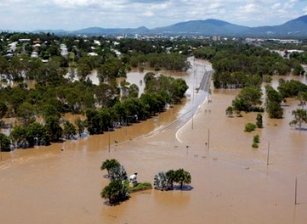 ROCKHAMPTON/PERTH, Australia (Reuters) – Australia’s flood-stricken coal industry faced lengthy disruptions on Thursday, with one miner saying it could take weeks to drain its pits of water and a major port suspending export shipments because of a lack of coal.
ROCKHAMPTON/PERTH, Australia (Reuters) – Australia’s flood-stricken coal industry faced lengthy disruptions on Thursday, with one miner saying it could take weeks to drain its pits of water and a major port suspending export shipments because of a lack of coal.
Floods have swamped mines in Queensland state, paralyzing operations that produce 35 percent of Australia’s estimated 259 million tonnes of exportable coal. Australia contributes two-thirds of global coking-coal exports, needed to make steel.
About 200,000 people scattered across an area the size of France and Germany combined have been affected by the flooding in Queensland. Damage from the floods, the worst in the state in 50 years, has been estimated at $5 billion.
One of Queensland’s two major coal ports, Gladstone, suspended exports on Thursday, starved of sufficient supplies from water-logged and marooned mines further inland.
Gladstone port normally blends together different coals at the waterfront before loading ships, but a port spokeswoman said it had insufficient quantities to continue blending to the same standard. It was now awaiting further guidance from miners.
“It’s the coal companies’ call as to whether they start loading that coal or not,” the spokeswoman told Reuters.
One commodities analyst estimated that 45 to 50 million tonnes of metallurgical-grade coal needed to make steel were under force majeure declarations, which temporarily release miners from delivery obligations.
“That doesn’t mean those tonnes are lost to the market, they are just saying there is a risk they might not be delivered on time,” said UBS commodities analyst Tom Price.
Also, production of roughly 8 percent of the world’s thermal coal production — used in power generation — has been temporarily eliminated by the flooding, according to Australia & New Zealand Bank analyst Mark Pervan.
Analysts expect steel coals to rise as much as a third to $300 a tonne in the aftermath of the floods, sweeping thermal coal prices higher in the process.
“You can’t have a lift in metallurgical coal prices without dragging up thermal coal,” Price said.
Asian steel-makers are anxious over Australian supplies, worried the disruptions could outlast their stockpiles, which typically hold around a month’s worth of consumption.
London-listed Anglo American, one of the nation’s top four miners of steel-making coal, said it could take some weeks to pump water out of its flooded mines and that it was too early to say when its collieries could resume operation.
“Our focus is currently on mobilizing our people and other resources and de-watering flooded coal pits, which we estimate will take some weeks,” Seamus French, head of the group’s metallurgical coal division, said in a statement.
Anglo has about seven coal mines in Queensland, the state that accounts for most of Australia’s coking-coal exports.
Anglo’s major rivals, Rio Tinto, Xstrata and BHP Billiton, have also been hit by the floods, and all have made force majeure declarations.
The flooding is already receding in some coal fields, but all four major producers still face supply disruptions and cannot say when operations would return to normal.
In 2008, flooding stalled some mines for as long as six months, but others began producing within six weeks, said Andrew Harrington, an analyst at Patersons Securities in Sydney.
Mines then raised output to recoup losses and ended the year about 10 percent below where they otherwise would have been.
“This time around, it’s happening a lot earlier, it looks a lot worse, and we’re still seeing more rainfall,” said Harrington.
CAMELS, HORSES AND SNAKES
Floodwaters have begun to slowly recede in some districts in Queensland, but were still rising in some areas further south, including around the town of St George.
In Rockhampton, a cattle town of 75,000, muddy flood waters had dropped a few inches overnight despite more heavy rains but it will take days before a cleanup can begin. On pockets of higher land, camels and horses grazed on people’s front lawns, while residents relied on boats to fetch supplies.
Most homes are built on stilts in the flood-prone area, so water had not risen above the floors in most cases.
Hospitals in central Queensland have also been stockpiling anti-venom, media reported, after snakes sought refuge in homes, including the deadly brown snake.
ECONOMIC COST PUT AT $5 BILLION
Three people have been killed in the floods and hundreds left homeless. The economic cost of the inundation, which some scientists are linking to global warming and rising sea temperatures, is already estimated at around $5 billion.
Roads, rail lines and bridges have been submerged, and authorities are waiting for the waters to recede before they can assess how much vital infrastructure needs rebuilding.
Australian stocks were flat on Thursday, undermined in part by worries over the impact of floods on mining profits.
Dalrymple Bay, the country’s largest coal export port, is operating but said on Thursday that deliveries to the port could dry up unless mines started reopening by the weekend.
“If we can’t get it in, we can’t ship it out,” said Dalrymple spokesman Greg Smith. Typically the port receives about 230,000-240,000 tonnes of coal daily from mines.
QR National, the country’s biggest coal freight business, said on Thursday it was ramping up operations on a reopened rail line, enabling coal to reach the coast, but problems remained elsewhere on other, larger lines.
QR National’s big Blackwater line remained closed, impacting operations for Wesfarmers, BHP, Xstrata and Rio Tinto.
(Additional reporting by James Regan and Amy Pyett)




